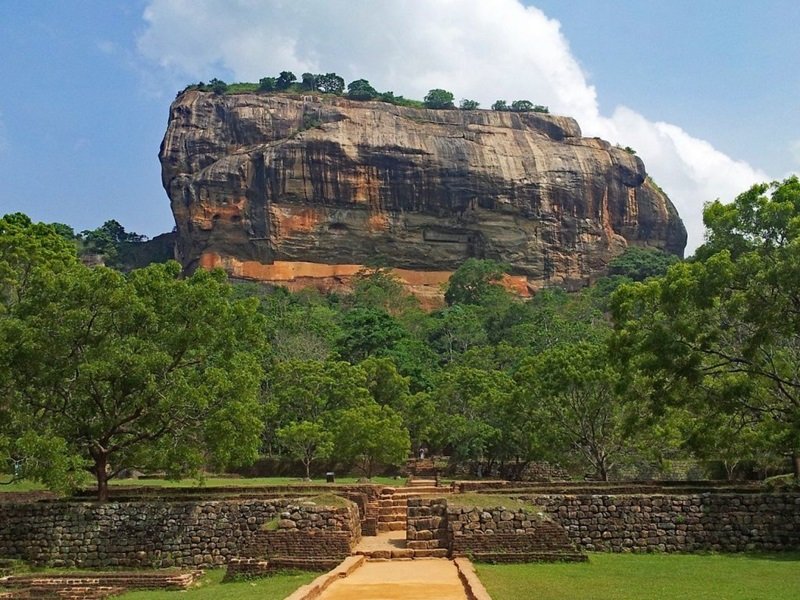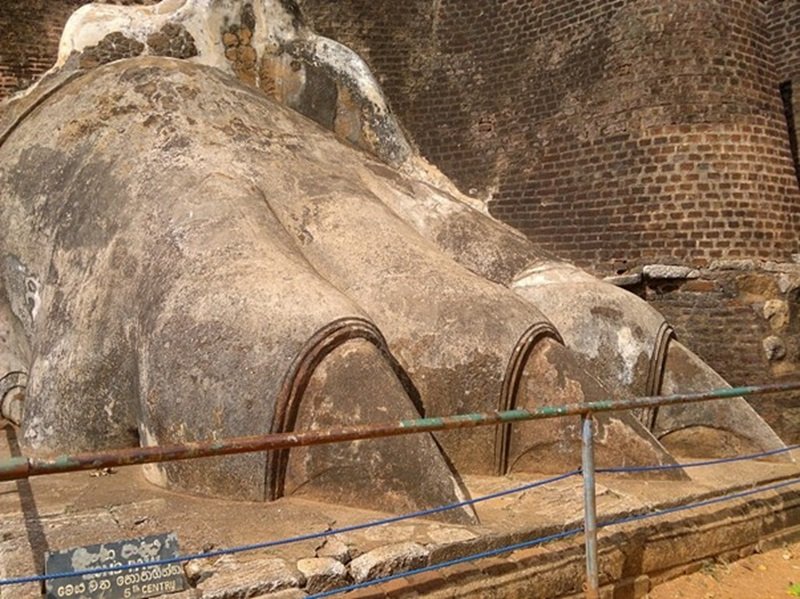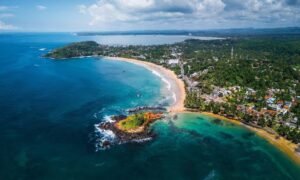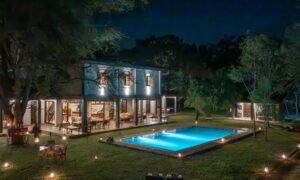Sigiriya Rock, known as the ‘eighth wonder’ by Sri Lankans, is a popular tourist destination not only among Sri Lankans but also among foreign tourists.

Sigiriya, site in central Sri Lanka consisting of the ruins of an ancient stronghold that was built in the late 5th century CE on a remarkable monolithic rock pillar. The rock, which is so steep that its top overhangs the sides, rises to an elevation of 1,144 feet (349 metres) above sea level and is some 600 feet (180 metres) above the surrounding plain.

Pic ; The Lion Gate and Climbing Stretch ; Credit by : Wikipedia
The Sinhalese king Kashyapa I (reigned 477–495) built a palace in the shape of a monumental lion on the several acres of ground at the summit, intending it to be a safeguard against his enemies. However, the king was defeated in 495, and the palace fell into ruin. The site soon became a pilgrimage destination, however, and it is now a popular tourist spot. Visitors begin the final ascent to the top through the open paws of the lion, one of the few remaining portions of the palace that are still intact. Also notable are 21 rock paintings of apsaras (celestial singers and dancers). Sigiriya was designated a UNESCO World Heritage site in 1982.
Pic: Sigiriya Lion Claws : There is a staircase in Sigiriya where you would see two enormous lion paws carved out of the rock. It will lead up to a gigantic lion statue. It represents the pride and the strength of King Kashyapa.

Credit by : Wikipedia – pic Close up of the Lion’s Paw
The term Sigiriya derives from Sinha-Giri which means ‘Lion Rock.’ HCP Bell excavated the two enormous lion paws in 1898.
The royal palace was built atop the rock while other buildings and gardens were built around the rock. Only the foundations of these structures remain now. The fortress city was built by King Kasyapa I and became a monastic refuge after his death. In the 16th and 17th centuries, it served as an outpost of the Kandyan kingdom but later went into ruin and was rediscovered in 1894/1895 by a British archaeologist, H.C.P. Bell. According to the researches of Dr Mirando Obesekara, He identify the Sigiriya as a historical turning point of Ravana. Before 50 centuries Sigiriya named as Alakamandawa (Akasa Maligawa).
The Indian ancient epic story “Ramayanaya” described the brother of Rawana (Kuwera/Waisrwana) is the owner of the Alakamandawa (Sigiriya).
King Kashyapa
Kashyapa I, also known as Kasyapa I or Kassapa I, was a king of Sri Lanka, who ruled the country from 473 to 495 CE. He was the second king of the royal Moriya dynasty of Sri Lanka. Kashyapa is credited with the construction of the Sigiriya citadel and the surrounding city. He selected the Sigiriya Rock as his Citadel and he was built his palace on top of the Sigiriya Rock with and amazing technology.
The Sigiri frescoes

Credit – Adobe
The Enigmatic Mirror Wall : King Kashyapa created a ‘mirror wall’ so highly polished that he could see his reflection as he walked by. There is also evidence of a wall, 140 metres long and 40 metres high, covered with paintings of ladies, more famously known as the “Sigiriya Frescoes”. These paintings are still partly visible today.
From over 500 paintings done on the Sigiri wall, only about 22 still remain, many destroyed by vandals over the years. That these paintings are still mostly intact and the colours remain bright, speak volumes about the talents of our artists of a bygone era and the techniques they used.
The frescoes, which remind one of the Ajanta cave paintings in India, are believed to have been painted in the fifth century AD. Some believe the women depicted in these paintings to be apsaras (heavenly beings) while others think they are noble women and their servants heading off to the temples nearby.
The paint used was made of various types of clay combined with different colours. The paintings were later restored by a reputed Italian artist named Luciano Maransi. It is believed that there were paintings all over the rock which were later destroyed. The frescoes are the only non-religious old paintings in Sri Lanka.
One of the most striking features of Sigiriya is its Mirror wall. In the old days, it was polished so thoroughly that the king could see his reflection. The Mirror wall is painted with inscriptions and poems written by the visitors of Sigiriya.
The most ancient inscriptions are dated from the 8th century. These inscriptions prove that Sigiriya was a tourist destination over a thousand years ago. Today, painting on the wall is strictly prohibited.
The gardens of Sigiriya are among the oldest landscaped gardens in the world. The gardens are divided into three distinct but linked forms: water gardens, cave and boulder gardens, and terraced gardens.

Engineering Technology of Sigiriya: The layout is organized in a way that on either side of the roads to the western entrance there are rectangular pools. In front of the pools, there are limestone fountains. The technology used is much advanced, and it is hard to believe how there could have been such technology during the ancient times.
Sigiriya is not a large town and doesn’t have a train station or bus terminal but you are within a tuk-tuk or taxi ride away from the town of Dambulla and it’s busy bus terminal. Dambulla is fantastically well connected to nearly the whole island with buses serving Kandy, Anuradhapura and Colombo as well as northern and southern towns.
Many of the larger bus routes can drop you off at Inamaluwa Junction. Inamaluwa Junction lies much closer to Sigiriya town than Dambulla, and many of the long-distance bus routes pass through here on their way to Dambulla. This is the junction we used to both arrive and depart from our stay in Sigiriya. When boarding the bus, just let the ticket seller know you’re heading to Sigiriya and they’ll let you know when you get to the junction. If you jump off the bus at this nondescript junction, you can easily flag a tuk tuk or taxi down to take you the short ride to Sigiriya itself.

Credit – Connie Felicity
For the budget friendly you can catch a bus between Sigiriya to Dambulla but the timetables are a mystery! Google has no idea, there is no bus stop in Sigiriya town (from what we could find) and our guesthouse advised us to just wait on the side of the road and try and flag the bus down when it rolled past.
There is also a train stations close(ish) by in Habarana and Kekirawa which are a short hop from Sigiriya. Habarana station has a train to Trincomalee in the north and the capital of Colombo although when we visited trains were not that frequent. You can book trains between Colombo and Kekirawa in advance here.
The western wall of Sigiriya was almost entirely covered by frescoes created during the reign of Kasyapa. Eighteen frescoes have survived to this day.
Sigiriya opens every day from 7:00 AM – 04:00 PM. You can easily climb the Sigiriya about 10-20 minutes from the bottom of the rock. Come to visit the Sigiriya & enjoy the beauty of this palace. I’m sure it will be an unforgettable memory of your travel life.

Wrote by – Madhu Wicramasingha








